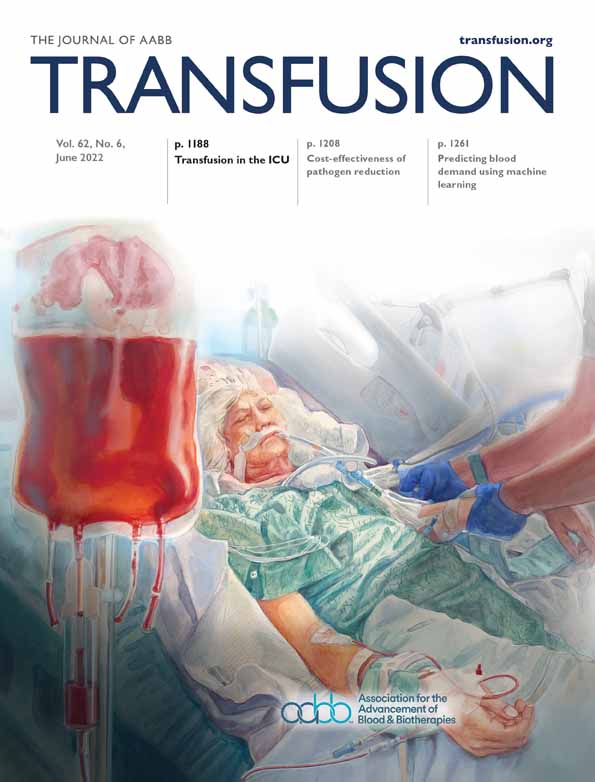What would it take to convince you to donate? A survey study of the relationship between motivators, barriers, and payment for whole blood, plasma, and platelet donation
Abstract
Background
With growing discussion about blood donor remuneration, the present study examined the level of payment that may be required to convince individuals to engage in whole blood, plasma, and platelet donations.
Study Design and Methods
Anonymous online surveys were completed by a college sample [n = 490; 76.9% female; Mean Age = 20.3 (SD = 4.9) years; 32.9% whole blood donors] and a ResearchMatch sample [n = 323; 70.6% female; Mean Age = 50.7 (SD = 16.6) years; 82.7% whole blood donors]. Level of payment needed to motivate whole blood, plasma, and platelet donation was examined as a function of donation history, sample, and gender. In addition, path analyses examined associations between donation motivators, barriers, and payment level.
Results
Across all types of donation, history of whole blood donation was related to a greater willingness to donate without payment. At the same time, however, sizeable portions of prior donors indicated that monetary payment would convince them to donate whole blood (24%), plasma (51%), or platelets (57%). Across all types of donation, donation-related barriers (i.e., anxiety, fear) were indirectly related to higher payment levels via lower self-efficacy and more negative donation attitudes. Donation-related motivators (i.e., warm glow, regret, and altruism) were indirectly related to lower payment levels via higher self-efficacy and more positive donation attitudes.
Conclusion
Despite reporting a strong commitment to nonremunerated blood donation, many respondents with and without a history of blood donation indicated that money would convince them to engage in whole blood, plasma, and platelet donation.
1 INTRODUCTION
Concerns about future blood shortages due to an aging donor pool have contributed to a growing discussion about donor payments in the United States,1-4 and the significance of this issue is only heightened by recent COVID-related challenges to the blood supply. Although opinion regarding the wisdom of paying blood donors is decidedly mixed, with concerns often centered on the possibility of undermining intrinsic motivation,5 it is generally agreed that more research is advisable to enhance our understanding of the potential implications of such a change.3, 6
One issue that is clearly deserving of further study is the possibility of the differential impact of incentives as a function of donor characteristics. For example, existing evidence suggests that younger donors may be particularly open to incentives, including cash incentives, early in their donation career.7-9 Beyond age and donation experience, other individual difference characteristics may also shape perceptions about the value of incentives including altruism, attitudes towards donation, concerns about the donation process, and confidence in one's ability to donate despite potential barriers. A second important issue is the possibility of differential impact of incentives as a function of the type of donation. Because the processes of whole blood donation, plasmapheresis, and plateletpheresis differ in a number of respects that may be important to potential donors (e.g., time required, convenience of collection site, needle size, red cell reinfusion, familiarity with the procedure), the level of incentive required for these different types of donation may vary.
To address these issues, the present study surveyed college and noncollege samples with and without a history of blood donation to examine the relationship between key donor motivation constructs and the level of monetary payment respondents indicated would be needed to convince them to engage in whole blood donation, plasma donation, and platelet donation. It was hypothesized that those with a history of whole blood donation would indicate that they required little or no payment to provide each type of blood donation and that college students would be willing to donate for less than a general adult sample due to lower earning power and a more flexible schedule that does not require loss of wages in order to find time to donate. Further, based on prior studies of donation intention and behavior,10-13 it was hypothesized that donation-related motivators (i.e., altruism, warm glow, regret, self-efficacy, attitude) would be inversely related to payment levels, whereas donation-related barriers (i.e., fear and anxiety) would be positively related to payments. Finally, consistent with evidence of self-efficacy and attitude as key mediators of donor intention and behavior,14, 15 analyses were conducted to examine how motivators and barriers may influence payment levels via donation-related self-efficacy and attitudes.
2 MATERIALS AND METHODS
2.1 Recruitment and participants
Participants were recruited simultaneously from two sources between August 2021 and December 2021. The first source of participants was an online experiment management system at a US Midwest university where undergraduate psychology students could choose to participate to obtain experience in research and course credit. The experiment management system provided a brief description of the study and a link to an online consent form and survey that were administered using survey software (Qualtrics, Provo, UT). This recruitment yielded 599 participants who indicated that they were eligible to donate blood, and this sample was reduced to 490 after omitting participants who failed questions embedded in the survey that were designed to assess attention and consistency of responding (see Procedure below). Participants in the final sample had a mean age of 20.3 years (SD = 4.9), with 86.5% being under 22 years of age (see Table 1). Most of the participants indicated that they were female (76.9% female, 22.7% male, 0.4% preferred another term) and the majority self-described as White (87.6% White, 4.9% Black or African-American, 1.6% Asian, 0.2% American Indian or Alaskan Native, and 5.5% more than one race or “Other”). With respect to ethnicity, 2.7% identified as Hispanic or Latino and 97.3% identified as Not Hispanic or Latino. A history of whole blood donation was reported by 32.9%.
| Age ranges | Undergraduate | ResearchMatch |
|---|---|---|
| 18–21 | 86.5% | 0.9% |
| 22–30 | 8.8% | 14.9% |
| 31–40 | 2.9% | 16.4% |
| 41–50 | 1.6% | 13.0% |
| 51–60 | 0.2% | 20.7% |
| 61–70 | 0% | 25.1% |
| 71–80 | 0% | 7.4% |
| 81–90 | 0% | 0.6% |
| 91–100 | 0% | 0.9% |
Simultaneously, a recruitment drive was also conducted using ResearchMatch, a national health volunteer registry that is supported by the U.S. National Institutes of Health as part of the Clinical Translational Science Award program. ResearchMatch has a large population of volunteers who have consented to be contacted by researchers about health studies for which they may be eligible. This recruitment yielded 337 participants who indicated that they were eligible to donate blood, and this sample was reduced to 323 after omitting participants who failed questions embedded in the survey that were designed to assess attention and consistency of responding (see Procedure below). This sample had a mean age of 50.7 years (SD = 16.6), with 90.1% being relatively evenly distributed between 22 and 70 years of age (see Table 1). Most of the sample indicated that they were female (70.6% female, 26.6% male, 2.8% preferred another term), and the majority self-described as White (90.4% White, 4.3% Black or African-American, 1.5% Asian, 0.6% American Indian or Alaskan Native, and 3.1% more than one race or “Other”). With respect to ethnicity, 6.5% identified as Hispanic or Latino and 93.5% identified as Not Hispanic or Latino. A history of whole blood donation was reported by 82.7%.
2.2 Survey materials
The survey measures used in the study are described in Table 2, including scale descriptions, sample items, rating end-points, and computed internal consistency reliability (i.e., Cronbach's alpha) values for the present sample. Each measure was scored by calculating the mean rating chosen by the participant across the scale items, yielding scale score totals ranging between 0 and 6 (for measures of anxiety, regret, warm glow, self-efficacy, and attitude) or between 0 and 4 (for measures of fear and altruism). In addition to these measures, participants also provided basic demographic information such as age, gender, race, ethnicity, and donation history.
| Measure | Description | Sample item | Rating end-points | Cronbach's α |
|---|---|---|---|---|
| Anxiety | Level of nervousness, tension, and anxiety with respect to donating blood (3 items).29 | “If I donate blood I will feel nervous.” | 0 (Not at all) to 6 (Very much) | .98 |
| Fear | Single-item measure of donation fear30-32 | “How afraid are you of having blood drawn from your arm?” | 0 (Not at all afraid) to 4 (Extremely afraid) | NA |
| Regret | Anticipated negative feelings with respect to not donating blood (3 items).29 | “If I do not donate blood within the next year, I will regret it.” | 0 (Very unlikely) to 6 (Very likely) | .94 |
| Warm Glow | Feelings of pleasure and satisfaction derived from an appraisal of contributing to the wellbeing of others through blood donation (3 items).33 | “I would feel good about myself if I donated blood.” | 0 (Not at all) to 6 (Completely) | .96 |
| Altruism | Identifying with the promotion of the welfare of others as the reason for donating blood (3 items).34 | “I would donate blood because I would be doing something to help others.” | 0 (Not at all true) to 4 (Extremely true) | .82 |
| Self-Efficacy | Confidence in one's ability to engage in blood donation and to cope with barriers that may arise (6 items).35 | “I am confident that I can cope with any concerns I may have about donating blood.” | 0 (Not at all) to 6 (Extremely) | .85 |
| Attitude | Thoughts and feelings about blood donation (6 items).36 | “For me, donating blood within the next year would be…” | 0 (Unpleasant) to 6 (Pleasant) | .86 |
2.3 Procedure
Following informed consent, participants provided general personal information including basic demographics (age, gender, race/ethnicity) and indicated whether they had a history of blood, plasma, or platelet donation. This was followed by the blood donation-related survey measures. Lastly, participants viewed a graphic with text and an illustration of the components of whole blood (i.e., plasma, white blood cells, platelets, red blood cells) followed by a series of descriptions of whole blood, plasma, and platelet donation (see Table S1). After each description participants were asked “What amount of money would convince you to make a ___,” with the blank replaced with either “whole blood donation,” “blood plasma donation,” or “blood platelet donation.” After each question they were given 12 response options, from “$0, I would do this without being paid” to “$100” in 10 dollar increments; and a final option of “I would not do this, even if I was paid.” Two questions to test for respondent attention were imbedded in the survey (e.g., “This question is to screen out automated responses: please choose the answer to FOUR - THREE =”). In addition, to assess consistency of responding, personal history of blood donation was re-assessed at the end of the survey (i.e., “How many times have you donated whole blood?”).
All study activities were completed online and participants' responses were anonymous to the researchers. Review and approval for this study and all procedures were obtained from the Institutional Review Board of Ohio University and the research was performed in accordance with the ethical standards of the Declaration of Helsinki.
2.4 Statistical analyses
Because the distributions of participants' responses regarding the amount of money needed to convince them to provide each of the different forms of blood donation were positively skewed (due to a high proportion of respondents selecting the lowest value of $0), analyses were conducted using nonparametric statistics. First, separate Mann–Whitney U tests were conducted to examine the effects of history of prior whole blood donation (yes/no), recruitment sample (college/ResearchMatch), and gender (male/female). Next, Spearman's rank correlations were conducted to examine relationships between each of the donor motivation constructs and level of monetary payment for each type of donation. These analyses were conducted using IBM SPSS Statistics 28.0 (IBM Corp., Armonk, NY) with significant differences defined as p < .05. Finally, path analyses were conducted to examine the relationship among motivators, barriers, and payment levels for each type of blood donation, with donor self-efficacy and attitude as potential mediators. Similar to multiple regression analysis, path analysis allows one to model the simultaneous relationships among multiple independent variables and a primary dependent variable. The models were fitted using a maximum likelihood estimation method with robust standard errors (estimation method MLR in Mplus), and a χ2 difference test was conducted after removing or adding a path to ensure improved fit. Analyses were conducted using Mplus Version 8.4, and p < .05 was used to denote statistical significance.
3 RESULTS
3.1 Whole blood donation
Analyses of payment to motivate whole blood donation revealed significant effects of blood donation history (U = 60682.5, Z = −7.539, p < .001), recruitment sample (U = 66280.5, Z = −4.556, p < .001), and gender (U = 65059.5, Z = 2.248, p = .025). As shown in Figure 1, these differences reflected a higher proportion of respondents willing to donate without payment among those with versus without a prior history of donation (76% and 50%, respectively, see Figure 1A), those recruited via ResearchMatch versus Ohio University (74% and 57%, respectively, see Figure 1B), and among women versus men (66% and 55%, respectively, see Figure 1C).
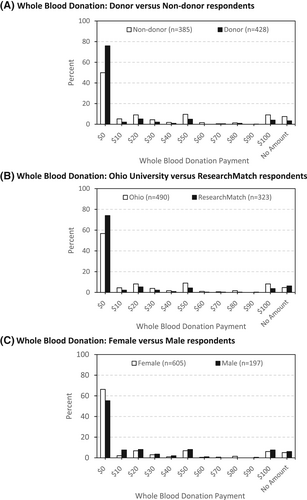
3.2 Plasma donation
Analyses of payment to motivate plasma donation revealed a significant effect of blood donation history (U = 70570.5, Z = −3.693, p < .001), but not recruitment sample (U = 76960.5, Z = −0.693, p = .488) or gender (U = 61908.5, Z = 0.857, p = .392). As shown in Figure 2, a higher proportion of respondents with a history of whole blood donation were willing to donate plasma without payment as compared to those without such a history (49% and 37%, respectively, see Figure 2A), whereas there was no significant difference in the distributions as a function of recruitment source (see Figure 2B) or gender (see Figure 2C).
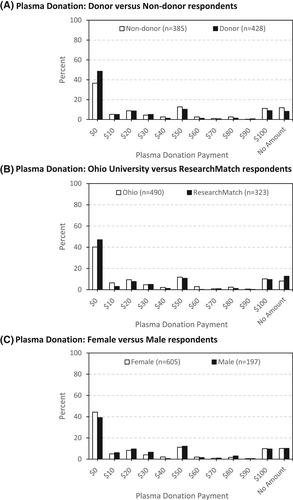
3.3 Platelet donation
Analyses of payment to motivate platelet donation revealed a significant effect of blood donation history (U = 71940.0, Z = −3.225, p = .001), but not recruitment sample (U = 78154.0, Z = −0.309, p = .757) or gender (U = 59619.5, Z = 0.010, p = .992). As shown in Figure 3, a higher proportion of respondents with a history of whole blood donation were willing to donate platelets without payment as compared to those without such a history (43% and 32%, respectively, see Figure 3A), whereas there was no significant difference in the distributions as a function of recruitment source (Figure 3B) or gender (see Figure 3C).
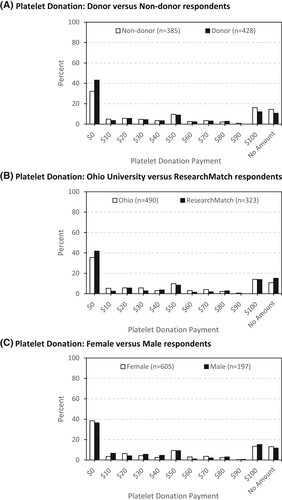
3.4 Correlation and path analyses
As shown in Table 3, all donor motivation variables were significantly related to monetary payment and the strengths of the relationships were similar across the three different types of blood donation. Further, as expected, anxiety and fear were associated with higher payments, whereas each of the other motivational variables was associated with lower payments across the donation types.
| Variable | Median (range) | 1 | 2 | 3 | 4 | 5 | 6 | 7 | 8 | 9 | 10 |
|---|---|---|---|---|---|---|---|---|---|---|---|
| 1. Anxiety | 3.0 (0–6) | — | .84 | −.15 | −.21 | −.03 | −.53 | −.62 | .37 | .34 | .35 |
| 2. Fear | 1.0 (0–4) | — | — | −.11 | −.20 | −.04 | −.51 | −.62 | .37 | .33 | .32 |
| 3. Regret | 2.0 (0–6) | — | — | — | .26 | .16 | .16 | .32 | −.23 | −.19 | −.19 |
| 4. Warm glow | 6.0 (0–6) | — | — | — | — | .48 | .41 | .47 | −.33 | −.28 | −.26 |
| 5. Altruism | 4.0 (0–4) | — | — | — | — | — | .20 | .28 | −.18 | −.17 | −.17 |
| 6. Self-efficacy | 5.2 (0–6) | — | — | — | — | — | — | .63 | −.41 | −.35 | −.32 |
| 7. Attitude | 4.2 (0–6) | — | — | — | — | — | — | — | −.50 | −.44 | −.42 |
| 8. Whole blood payment | $0 (0–100) | — | — | — | — | — | — | — | — | .71 | .63 |
| 9. Plasma payment | $20 (0–100) | — | — | — | — | — | — | — | — | — | .88 |
| 10. Platelet payment | $30 (0–100) | — | — | — | — | — | — | — | — | — | — |
- Note: Shaded cells indicate significant correlation values at p ≤ .001 (two-tailed).
Figure 4 illustrates the results of the final model of the relationship among donor motivators and barriers and level of monetary payment to engage in whole blood donation. This model had a strong fit to the data [Root Mean Square Error of Approximation (RMSEA) = 0.038 with 90% CI (0.010, 0.064); Comparative Fit Index (CFI) = 0.992; Standardized Root Mean Square Residual (SRMR) = 0.028], and indicates that anxiety and fear had indirect effects on donation payment via lower donation self-efficacy and less positive attitudes. Hence, donors with higher anxiety and fear were less confident in their ability to donate and had more negative attitudes toward donation, which in turn were related to higher payments to convince them to donate. On the other hand, higher warm glow was associated with both greater confidence and more positive attitudes, and altruism and regret were associated with more positive attitudes. Thus, the relationship between warm glow, regret, and altruism with lower payment can be seen as mediated through their associations with higher confidence (among those with higher warm glow) and more positive attitudes towards donation (among those with higher warm glow, regret and altruism). A total of 27.7% of the variance in payment to engage in whole blood donation was accounted for by donor self-efficacy and attitude.
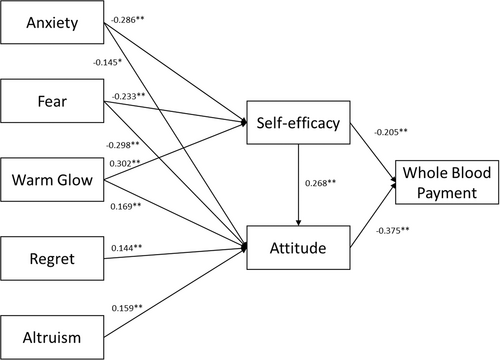
As shown in Figure 5, similar relationships were observed for the path analysis of plasma donation payment, and the model also had a strong fit to the data [RMSEA = 0.023 with 90% CI (0.000, 0.052); CFI = 0.997; SRMR = 0.021]. A total of 21.8% of the variance in payment to engage in plasma donation was accounted for by donor self-efficacy and attitude.
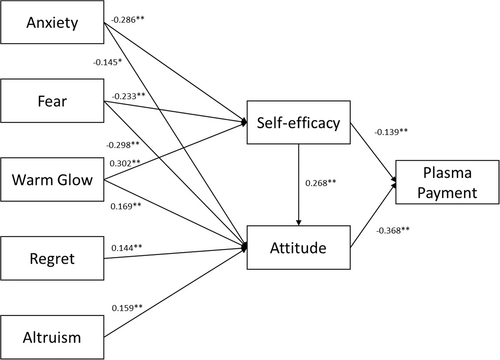
Finally, Figure 6 shows similar relationships for the path analysis of platelet donation payment, and the model had a strong fit to the data [RMSEA = 0.034 with 90% CI (0.000, 0.060); CFI = 0.994; SRMR = 0.023]. A total of 19.7% of the variance in payment to engage in platelet donation was accounted for by donor self-efficacy and attitude.
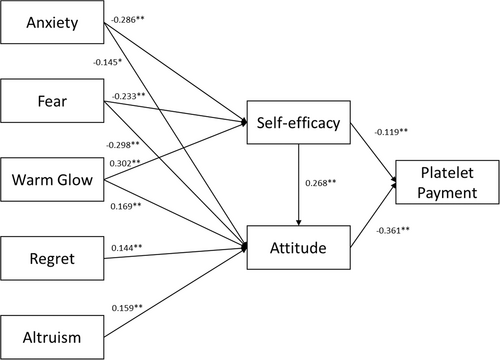
4 DISCUSSION
Consistent with our hypothesis, across the three different forms of blood donation a higher proportion of those with a history of whole blood donation indicated that they were willing to donate for no monetary compensation. This finding, which is in line with prior evidence of existing blood donors reporting less interest in (or a negative view of) monetary payments to give blood,16, 17 was particularly prominent for whole blood donation where 76% of prior whole blood donors indicated that they would give for no compensation as compared to 50% of those who had never donated whole blood. A significant difference was also apparent for plasma and platelet donation, but for these types of donation, less than half of prior whole blood donors were willing to donate for free versus approximately one-third of those without a history of whole blood donation. There are several possible reasons why whole blood donation had the highest proportion of respondents willing to donate without compensation. First, many of these respondents have a history of donating whole blood without compensation. A second, related explanation is that plasma and platelet donation would be novel procedures for most of the sample, hence they may be more reticent to engage in them without some added payment. Third, plasma and platelet donation may have fewer respondents willing to donate for no compensation because these procedures require a greater commitment of time and involve filtering and return of blood products which may introduce unique concerns for some prospective donors.18
We also predicted that college students would be willing to donate for less remuneration than a general adult sample, however, this was not confirmed. Specifically, relative to the college sample, a significantly higher proportion of ResearchMatch respondents indicated that they would donate whole blood for no compensation (i.e., 74% vs. 57%), and there was no significant difference in the distribution of level of compensation needed for plasma or platelet donation. In the present sample, this may be related to the fact that a higher percentage of ResearchMatch participants than college students (i.e., 83% vs. 33%) had a history of whole blood donation. Alternatively, the greater willingness to donate whole blood for no compensation among ResearchMatch respondents may reflect an age effect. Given the importance of young donors to the blood supply, the interest in compensation indicated by the college population deserves further attention, and a greater exploration of the potential influence of payment for donation in both high school and college students is warranted.
Although we did not make predictions related to respondent gender, it was observed that a significantly higher proportion of women than men indicated that they would donate whole blood without compensation (i.e., 66% vs. 55%). As in prior studies of blood donor motivations,19, 20 this difference may be related to greater altruism as women in the present sample did have higher average scores than men, t(800) = 4.18, p < .001. On the other hand, there was no gender difference observed for plasma or platelet donation, suggesting that more complex explanations that account for differential perceptions of whole blood versus other forms of donation are necessary. Indeed, the results of the path analyses demonstrated that a number of psychological motivators (e.g., altruism, warm glow) and barriers (e.g., fear, anxiety) influenced payment perceptions, and each of these motivators and barriers may differ as a function of gender, prior experience, and a host of other factors.
To some extent, the current data can be seen as encouraging for a voluntary blood donation system in that, even among those who had not previously donated, half of all respondents indicated that they would donate whole blood for no payment and approximately one-third indicated that they would donate plasma or platelets without compensation. At the same time, even among respondents with a history of whole blood donation, a sizeable proportion indicated that they would require some level of payment (or in the extreme could never be convinced regardless of the level of payment) to donate whole blood (24%), plasma (51%), or platelets (57%). Taken together, these data suggest that although a sizeable portion of the population reports being willing to donate blood without compensation, there are many people who have not previously donated for free who indicate that they would require remuneration for their time to convince them to donate. For this group, the present findings provide some indication of how much money might be sufficient to motivate donation behavior. Of course, at this stage we do not have sufficient data to draw firm conclusions, as further investigation is needed to understand the extent of possible positive outcomes (e.g., increasing the proportion of the eligible population who donate blood) as well as the potential negative repercussions (e.g., demotivating some existing donors) that may arise from the offer of remuneration. However, prior evidence suggests that results can vary between studies that survey opinions about monetary incentive for blood donation versus studies that measure actual donation behavior when incentives are provided.5 Specifically, whereas survey respondents often minimize the importance of payment, or even claim that it would serve as a disincentive, in studies where incentives are offered, they typically increase donation behavior.21
Multiple applications of the Theory of Planned Behavior to the blood donation context support the central role of donation self-efficacy and attitude as key determinants of donation intention and behavior.10-13, 22, 23 Results of the present study demonstrate that these variables are also significantly related to perceptions of the level of remuneration required for various forms of blood donation. Specifically, individuals with higher self-efficacy and more positive donation attitudes indicate that they require less payment (and, for many respondents, no payment) to engage in donation behavior. Path analyses also support the notion that donation self-efficacy is lower among those with donation-related anxiety and fear, and higher among those who derive pleasure and satisfaction (i.e., warm glow) from donating. In addition, donation-related anxiety and fear are also associated with more negative attitudes toward donation, whereas donation-related warm glow, regret at the thought of not giving, and altruism are each associated with more positive donation attitudes. As a whole, the results of the path analyses suggest that the same types of psychological motivators and barriers that contribute to donate intention also shape individual perceptions of the amount of payment required. This is novel information and may offer some insight into ways in which current nondonors, and particularly those who indicate a preference for being paid to donate blood, may become part of the donor population. On the one hand, this may be accomplished by offering the level of payment that they deemed necessary to motivate them. On the other hand, these prospective donors may also be willing to donate for less money, and perhaps even no payment, if we help to alleviate their fear and anxiety and increase their confidence.14, 24 In addition, we could work toward similar outcomes by activating demonstrated motivators such as warm glow and anticipated regret.25
Although an important strength of the present study was recruitment of both donors and non-donors from two different sources, as with any study there are also limitations that must be considered when interpreting the findings. First, in line with many survey studies the present sample was predominantly female,26-28 and as a whole was largely white and non-Hispanic, hence caution is obviously required in generalizing the findings to the population as a whole. Second, whereas approximately half of the sample reported a history of whole blood donation, only about 10% of the sample had similar histories of plasma and platelet donation. Although this may be reasonably representative of the population, it highlights the possibility that the observed relationships may be predominant among those with less knowledge of, or experience with, procedures beyond the more common whole blood donation. Finally, the survey was conducted during the COVID pandemic, during which time there were frequent appeals for blood product donations, and in particular convalescent plasma donation. This milieu may have temporarily skewed participants towards a more beneficent stance regarding payment for donation of blood products.
In sum, the present findings demonstrated a significant commitment to non-remunerated blood donation, particularly for whole blood collections. At the same time, however, at least half of all respondents without a history of whole blood donation were open to the idea of cash payment as an incentive for whole blood, plasma, and platelet donation.
CONFLICT OF INTEREST
The authors have disclosed no conflicts of interest.



